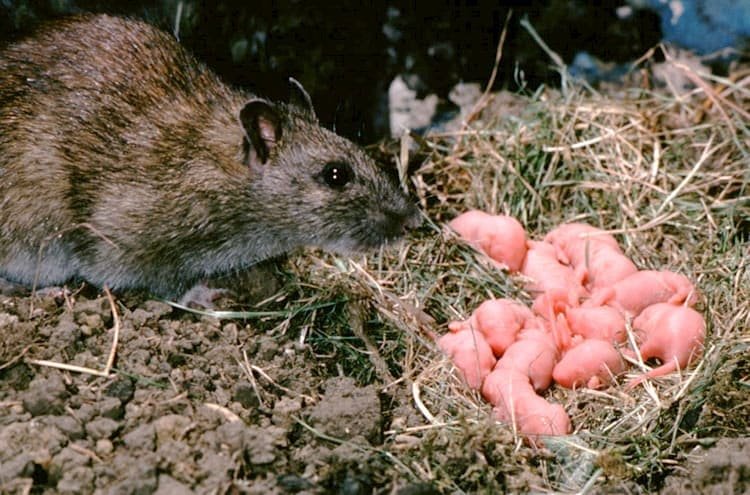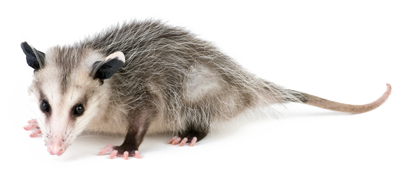Rats
What does a rat look like ?
Rats are small mammals that belong to the rodent family, Muridae. There are many different types of rats, but the two most commonly known are the Norway rat (Rattus norvegicus) and the roof rat (Rattus rattus). Norway rats are also called brown rats or wharf rats and are typically larger and more aggressive than roof rats. Roof rats are also known as black rats or ship rats and are generally smaller in size and more agile, before they were called roof rats they were called tree rats, but modern construction has made it so that now we have to know How to get rid of rats in the attic.
Rat vs Mouse : How to tell the difference
RAT
Baby rat
rAT FACTS - ALL YOU NEED TO KNOW
The lifespan of a rat can vary depending on the species and the environment in which it lives.
In the wild, rats typically live for 1-2 years, with some living up to 3 years. However, when kept as pets or in laboratory settings, they can live up to 3-4 years with proper care.
It's worth noting that the lifespan of a rat can also be affected by a number of factors, such as genetics, nutrition, disease, and the presence of predators or other threats. Rats that live in wild conditions will have a shorter lifespan than those that live in captivity because of the many dangers they face in the wild.
In addition, Wild rats tend to have a shorter lifespan than their laboratory counterparts as they are exposed to more diseases, predators, and environmental hazards, and have to constantly search for food and shelter.
Normative Values for Rats
Lifespan 1-3 years
Adult weight : Males 20-30 g / Females 18-35g
Birth weight : 1-2 g - Heart rate 310-840 beats per minute
Respiratory rate 80-230 breaths per minute - Body temperature 36.5-38°C
The lifespan of a Rat can vary depending on the species and the conditions in which it lives. In the wild, Rats typically live for around 6 to 12 months. However, Rats kept in captivity as pets or lab animals can live for up to 2 years with proper care. The lifespan of a Rat also depends on factors such as diet, genetics, and exposure to disease or predators
The lifespan of a Rat can vary depending on the species and the conditions in which it lives. In the wild, Rats typically live for around 6 to 12 months. However, Rats kept in captivity as pets or lab animals can live for up to 2 years with proper care. The lifespan of a Rat also depends on factors such as diet, genetics, and exposure to disease or predators
How many babies do Rats have?
Rats typically have large litters of babies, also known as pups. The number of pups per litter varies depending on the species of rat and the individual female, but it can be quite high.
For example, Norway rats can have litters of up to 14 pups, and can have up to 7 litters per year. Black rats can have litters of up to 12 pups and can have up to 5 litters per year.
It's worth noting that the number of pups per litter can also be affected by environmental factors such as food availability, population density, and stress.
Also, the rate of reproduction of rats is very high, females reach sexual maturity in just three to four weeks and can breed year-round. This, along with their ability to adapt to a wide range of habitats, is one of the reasons why rat populations can grow quickly and become a problem in urban areas
Are Rat / Rats nocturnal ?
Rats are generally considered to be nocturnal animals, meaning they are most active at night. This behavior is thought to have evolved as a way for them to avoid predators and to take advantage of the cooler temperatures and lower levels of light during the night. However, some Rats species are considered crepuscular, which means they are active during the twilight hours of dawn and dusk. This can vary depending on the species, the environment, and the availability of food.
What eats Rats / Rat ?
Owls, Hawks, and other birds of prey: These birds hunt Rats by using their sharp talons and beaks.
Snakes: Many species of snakes, such as the garter snake and the black rat snake, eat Rats as a regular part of their diet.
Foxes, coyotes, and other mammals: These animals are known to hunt and eat Rats, especially in areas where larger prey is scarce.
Domestic Cats: Cats are natural hunters, and they often catch and eat Rats.
Additionally, some insects such as praying mantis are also known to eat Rats.
It's worth noting that Rats also fall prey to humans, as they are often considered pests and are trapped or poisoned to control their populations.
Do people eat Rats ?
In some cultures and parts of the world, eating Rats is not uncommon, especially in times of food scarcity, and it is considered a delicacy. However, in most developed countries, the idea of eating Rats is considered unappetizing and it is not a common practice. Eating Rats is also not considered safe due to the risk of disease transmission from the rodent to humans.
It's worth noting that in some cultures eating Rats is considered taboo and is not allowed by the culture's customs or religion.
It's important to be aware of the laws and regulations in your area regarding the consumption of wild animals, as it may be illegal in some places.
How do people eat Rats ?
In cultures where eating Rats is traditional, it is usually prepared in a variety of ways, depending on the region and the preference of the people.
In some cultures, Rats are roasted or grilled, and are often eaten as a delicacy.
In others, they are boiled or fried.
Some people also smoke or dry them to preserve them for later consumption.
It's worth noting that when Rats are consumed as food, it is typically the adult Rats that are used, and not the babies or "pups."
RAT
Rats have a stocky body shape, with short fur that can be brown, gray, or black in color. They have large ears and eyes, and a long, thin tail. They have large incisors that continuously grow and need to gnaw on hard objects to keep them filed down. Their diet consists of a wide variety of food items including seeds, fruits, vegetables, and even insects and meat.
Rats are highly adaptable animals and can be found in a wide range of environments, including urban, suburban, and rural areas. They are primarily nocturnal and are skilled climbers and swimmers. Rats are known to be highly social animals and live in large colonies or communities. They are also known to be carriers of diseases such as the bubonic plague and leptospirosis. They can also cause damage to homes and buildings by gnawing on electrical wiring, which can pose a fire hazard, an easy way of telling if you have rats around your home is by actually noticing rat poop.
RAT BEHAVIOR
Rats are highly social animals and live in large colonies or communities. They are territorial and establish dominance hierarchies within their colonies. Rats are known to be curious and intelligent animals, and are able to learn and remember complex tasks. They are also known to be adaptable and can quickly learn to avoid traps or other forms of control measures.
Rats are nocturnal animals and are most active at night. They spend most of their day in burrows or other hiding places, and come out at night to forage for food. They are skilled climbers and can easily climb walls, trees, and other structures to find food or shelter. They are also strong swimmers and can hold their breath for several minutes while diving for food.
Rats are known to be carriers of diseases such as the bubonic plague and leptospirosis. They can also cause damage to homes and buildings by gnawing on electrical wiring, which can pose a fire hazard. They also spread food-borne illnesses by contaminating food and surfaces. They can also damage gardens, crops and stored food. They are also known to gnaw on plastic and other materials, they can also chew through walls and insulation, which can cause structural damage to buildings.
Rats are also known to be vocal animals and communicate with each other using a variety of sounds, including squeaks, chirps, and squeals. They use these sounds to communicate information about food sources, potential predators, and social interactions within the colony
RATS - Lesser know facts
An interesting fact about rats is that they are highly social animals and form complex social hierarchies within their colonies. They communicate with each other using a variety of vocalizations, such as squeaks and chirps, as well as through chemical cues such as pheromones.
Rats also have a very good memory and are able to navigate their way through complex mazes and find their way back to their home base with ease. They can also recognize other rats they have previously met, and can remember the location of food and other resources for long periods of time.
Another interesting fact is that rats are very adaptable animals, they are able to live in a wide range of environments, from deserts to rainforests, and have been known to thrive in human-made environments such as cities and suburbs.
Rats have also played a significant role in human history, they have been both a pest and a helpful animal to humans. They have been a source of food and a carrier of diseases throughout the centuries, but also played an important role in scientific research, particularly in the fields of psychology and medicine.
Lastly, rats are known for their intelligence and problem-solving abilities, which have made them a popular subject for research in fields such as neuroscience and behavioral biology
RATS
The rat is a common rodent that is found in many parts of the world. One of the most well-known species of rat is the Rattus rattus, also known as the black or ship rat. This species is known for its ability to spread disease and is considered a pest. Another common species of rat is the Rattus norvegicus, also known as the brown or Norway rat. This species is larger than the black rat and is typically found in urban areas.
The mole rat, or Bathyergidae, is a type of burrowing rodent that is native to Africa. These rats are known for their small size and their ability to dig extensive underground tunnels.
The pack rat, or Neotoma, is a type of rodent that is found in North and South America. These rats are known for their ability to collect and hoard a variety of objects, including shiny objects, and are often found in desert regions.
Pet rats are becoming increasingly popular as a domestic animal. They are known for their intelligence and affectionate nature. Some popular breeds of pet rats include the Dumbo rat, which has large ears, and the fancy rat, which comes in a variety of colors and patterns.
Rat cages come in a variety of sizes and styles, and are used to house pet rats. They should be large enough to provide room for the rats to move around, and should be made of a sturdy material that can withstand the wear and tear of the rats.
RATS
Big rats and giant rats can refer to both wild and domestic rats that are larger than average. In the wild, they might be considered as pests and are usually controlled by rat catchers or exterminators. A giant rat can also refer to a domesticated rat that has been selectively bred to be larger than average.
Water rats, also known as the genus Hydromys, are a group of aquatic rodents found in Australia and New Guinea. They are good swimmers and divers, and their diet consists mostly of fish and crustaceans.
White rats are a type of albino rat that lack pigmentation in their skin, eyes, and fur. Dumbo rats, as their name suggests, have large ears that are set low on their head and are considered to be cute. Hairless rats are a domesticated breed of rat that lack fur. Roof rats are also known as black rats and are known for climbing and nesting in high places.
Rodenticide is a type of pesticide that is specifically designed to kill rats and other rodents. It is commonly used by pest control professionals and homeowners to control rat infestations.
The Norway rat, also known as the brown rat, is a widespread and common species of rat that is found throughout the world. It is a large, burrowing rodent that is known for its ability to adapt to a wide range of environments.
Fancy rats are a domesticated breed of rat that are kept as pets. They come in a wide variety of colors and patterns, and are known for their intelligence and affectionate nature.
Killing rats with salt is not a recommended method of pest control, as it can be inhumane and may not be effective. A more humane and effective method of controlling rat populations is through the use of traps and rodenticides.
Sewer rats are a subspecies of the brown rat that are known for living in underground sewers and drainage systems. They are typically larger and more aggressive than other types of rats, and are known for their ability to spread disease.
articles:
What does a rat nest look like ?
What is a Squirrel King
Click the links below to learn more about the animals in the pictures











